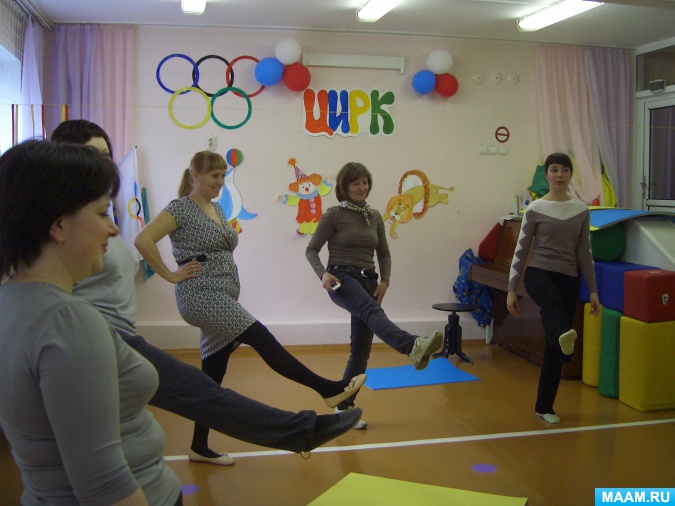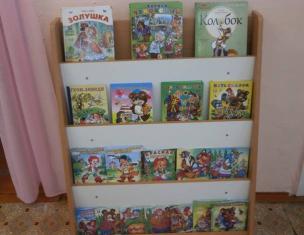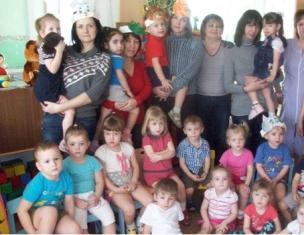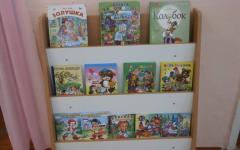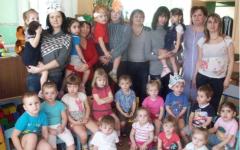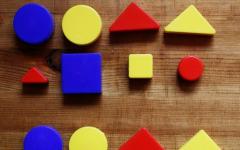and \u003d Irina Dobrygin
purpose: Representing the experience of using fizminutka as one of the forms of gymnastics.
Tasks:
1. Remind the methodology fizkultminokok in kindergarten.
2. To introduce a variety of forms of fizkultminutok
3. Enrich the pedagogical piggy bank.
1. relevance.
It has long been noticed: For literacy, the world of adults for some reason pays its health. The painful pallor, a horn back, Pensne on the nose, and often a charity - increasingly became the attributes of the educated intelligentsia in the past two centuries.
As soon as universal learning touched upon children of preschool and school, age immediately same: Myopia, curvature of the back, scoliosis, neurasthenia and much more. Back in 1805, Pestalotzi said that in traditional learning there was incomprehensible "Relaxation" Development of children "murder" their health. And this happened even in environmentally friendly times, when the children were born with normal childbirth from healthy parents and fed up breast milk. When there were qualitatively different families and information overloads at school were not so great.
Meanwhile, in practice, in all serious studies on the analysis of the occurrence of diseases of civilization (heart, vision, psyche, musculoskeletal system, etc., the seating factor is attributed to basic risk factors in the emergence of the most severe somatic pathology of our time (violation of vision, posture).
Classes with children in learning diploma, mathematics, visual activity, etc., board games more often occur in a fixed static state. But long-term stay in one position, one position for children, especially preschool age, is a very heavy load, since they are characterized by instability of nerve processes. They are quickly tired, attention decreases, interest in the game or occupation is lost, which, of course, negatively affects their effectiveness. As a result of a long static voltage in a child, a spin is laid, the shoulders are lowered, the blood circulation is slowed down, which leads to a violation of posture, adversely affects the work of vital functions of the body, as a result, negatively affects the health of the preschooler.
Especially tedious for children of this age. Long-term monotonous work or tasks that do not cause live interest from them, and volitional efforts necessary for their fulfillment are still not developed.
During classes with children, it is often necessary to change the activities of activities, to interest them with some bright, unusual subject or diversify often repeated actions, tasks some new, attractive element for a child. Therefore, it is important to prevent the occurrence of fatigue, timely detect signs of its appearance and as soon as possible, it is more effective to remove them, as fatigue, accumulating, can grow into overwork and cause the occurrence of various nervous disorders.
Signs of fatigue in children 3-4 years old appear after 7-9 minutes of classes, in children 5-6 years old - after 10-12 minutes, 7-8 years - after 12-15 minutes. They can express difficult: Zevaota, scattered attention, distractions, irritability, advent of automatic, involuntary adverse moves (scratching, tapping, swinging on a chair, sucking your fingers, etc., violation of posture and coordination of movements.
One of the effective ways to prevent fatigue, improving the overall state of children, the change of their activities is considered short-term exercise, the so-called fizkultminutki.
They remove the tension of the muscles caused by a fixed state, switch attention from one activity to another, giving the rest of the nervous centers involved in it, restore the health of children, help to have fun, remove the tension, get a feeling of physical discharge, improve blood circulation, activate children's thinking, create positive emotions. And increase interest in classes.
2. Basic ideas.
Based on the foregoing, the significance of this form of physical education is obvious, but only in the case of its proper. Educators do not always withstand temporary framework: spend fizkultminutka or earlieror later, or completely forget about it. Duration fizkultminutki limited to 15-30 seconds. Exercises are not selected in accordance with age and requirements for fizkultminutok I., very often, forget, what load the muscles of the back are carrying at the seat at the table. I consider the necessary moment when conducting fizkultminutok - Unload the back muscles. To do this, it is necessary to perform 1-2 exercises in the pose lying. In this case, the muscles of the spine caps are fully relaxed, and the intervertebral discs do not test vertical pressure (Unlike poses standing). Exercises for hands and legs can be done in the lying position. The number of exercises to bring up to 5-7 (2 for hands and shoulder belts, 2-3 for body and 1-2 feet).
I want to pay attention to the preschool pose at the table during the class. There is another, more democratic when the head and the spine are on one straight line, and the hands are free to lie on the table. Regular exercises to strengthen the abdominal muscles and back helps to work out a muscular frame that will not allow the spinal curvature. It is easier to prevent the posture violation, rather than fix it.
In addition, before the start of the lesson, it is better to do an exercise that includes a child in activities. Such exercises occupy a minimum of time, and the benefits of them are significant. Be sure to include in the complex an exercise for removing the stress from the eye.
3. Theoretical part.
Fizkultminutki held in the middle of the classes within 1.5-2 minutes; It is recommended to conduct starting from the middle group.
Basic forms of holding fizkultminutok:
In the form of general array exercises - are selected according to the same signs as for morning gymnastics. Used 3-4 exercises (according to the generally accepted technique) for different muscle groups, finish fizkultminutka can jump, running in place or walking;
In the form of a mobile game - the games of medium mobility, which do not require large space, with simple and familiar children with the rules;
In the form of a didactic game with movements - well fit into classes in familiarization with nature, on sound (phonetic) Culture of speech, in mathematics;
In the form of dance movements - used between the structural parts of the occupation under the sound recording, the singing of the educator or children themselves. Moderate rhythm melodies are most suitable, soft, sometimes smooth.
In the form of performing movements for the text of the poem - when selecting poems, attention is drawn to following:
The text of the poem should be highly artistic, the verses of famous authors, sweatshops, riddles, counters are used;
The advantage is given to poems with a clear rhythm;
In the form of any motor action and task
Guessing riddles not in words, but movements;
Use of various imitation movements: athletes (skier, skater, boxer, gymnast, individual labor actions (ruby firewood, we start the motor, we are going on the car).
Requirements for conduct fizkultminutok:
Held at the initial stage of fatigue (8-12-15th minute lessons, depending on age, type of activity, complexity of educational material);
Exercises should be simple in structure, interesting and familiar to children;
Exercises should be convenient for limited area;
Exercises should include movements affecting major muscle groups that improve the functional activities of all organs and systems;
Complexes fizkultminutok We are selected depending on the type of occupation, their content.
Complex fizkultminutki usually consists of 3-4 exercise: for hands and shoulder belts, for body and legs. If the complex is 1.5-2 minutes, it turns out 25-30 seconds. on one exercise. It is enough 15-20 seconds per exercise, then the complex becomes more dynamic and interesting, consisting of 5-7 simple exercises.
For hands and shoulder belts include exercises such as sipping - for straightening and relaxing the spine, breast expansion; for the body - slopes, turns; For legs - squats, cock, running on the spot, lifting legs. Most of the exercises associated with the development of large muscle groups and overall coordination, as well as vision, should be carried out in a position of free standing or lying, in the mode of motor freedom of dynamic pos.
As a result, physkultminutka turns into"Wellness Minutes" And it will look like the following way:
Exercise for inclusion in activities (5-10 seconds at the beginning of the classes);
For hands and shoulder belts;
For the body;
For legs;
For prevention of violation of vision and removal of fatigue from the eye (in the middle and at the end of the lesson).
Change of pose pupil (2-3 times during class).
4. Practical part.
Exercises for inclusion in activity:
1. Rubbing palms to easy tingling in the fingers (increases the productivity of the brain).
2. Rubbing palms of ear-sinks.
3. Rubbing the uha uha index and thumb.
4 Rubbing the forehead by nameless, middle, index fingers from the middle to the periphery (activates the attention zone).
5. Nasal massage in order to stimulate the brain activity, since the nose -Wine reflexogenic area of \u200b\u200bthe face. It is associated with the stomach, intestines, spleen, ns
Index and middle fingers click on the tip of the nose;
Flexion of the tip of the nose to the right, left;
Flexion of the tip of the nose down, up;
Rotation of the tip of the nose clockwise ,.
Exercises for the eye:
Close the eyes for 3-5 seconds, relax 2-3 seconds. / 3-5 times /.
Quickly frog for 8-10 seconds, after 2-3 seconds, repeat again;
The bottom of the palm to massate the eyelids circular motions is 10-20 seconds; Describe the circumference of the large size right to left and vice versa / by 2-3 times /;
Test eyes up and down, right-left, in the lower right corner - in the upper left corner, in the right upper angle - in the left bottom (on the end of a long pointer, a bright butterfly is fixed, the teacher leads the pointer, and the children follow the butterfly.);
"paint" Vertical and horizontal eights, ranging from the bridge top to the right, and then on the left. Previous and this exercises are performed with a maximum amplitude. If the entire cycle of exercises is done, to relax (Palming) - rub the palm to the appearance of heat, put the fingers of one palm to another and palms cover your eyes, linger in this position for 30-40 seconds. Palming is preferably made in the middle and at the end of the lesson, as well as after watching the video. During the execution of children, the exercise The teacher says several phrases type: "The eyes are tired, they want to relax, the dark, dark night, etc., came.";
Left palm to obscure an open left eye, and the fingers right to fold into the fist so that the thumb end up on top of all the others. Release the average finger and make them circular movements near the right eye, starting from the inner corner of the eye up the eyebrow line to external and again to the inner corner of the eye. At the same time, follow the right eye for the movement of the finger, without losing sight of it, is important. The movements of the finger and the eyes should be smooth and calm. The same, changing hands. Gradually bring the exercise to 3 minutes;
To remove eye fatigue - wash cold water ,.
Exercises with signal tags.
1. Write Matreyshek (or something different) on shelves. Where is the nephew in blue (red, green, etc.) Sarafan?
2. Parsley came to visit and brought the letter. Parsley shows the children a picture with the letter, children are looking for an object that begins on this letter in the surrounding environment.
Alternative pose of the pupil for table: Hands freely put on the table, stretching a little forward and bent in the elbows, palms down, up or sideways. 1-2 times at each occupation take a position in which the head and the spine are on one straight line. This will help improve the blood supply to the brain,
Fizkultminthki based on.
Complex "Beautiful posture". (After each exercise to make 2-3 inhalation and exhalation, extending exhalation)
1. Standing at the table, legs together, the feet are pressed to the floor, the hands are omitted, the back is straight. Smoothly lift hands up, palms to each other, fingers together. Extract to all body, attention to the spine. Keep pose 10-15 seconds, (Wood).
2. Standing, hands are omitted. Playing hands behind the back, connect the palms. Afterverting the hands folded with your fingers, position the brushes so that the maizins along the entire length touches the spine. Elbows lift, straighten, chest expand, shoulders back. Hold the pose to 20 seconds. Slowly return to and. P. Pust the wrists, shake the brushes. (Divine Pose.).
3. The previous posture can be replaced by this. The back concerns the back of the chair or standing, the hands are omitted, the shoulders are reserved back. Take your hands behind the castle, straighten and slowly raise up, without tilting the body. Smoothly lower your hands. (3-10 seconds, Swan Pose.)
4. Stand right. Right hand with power pull up, left down down. Right hand omit down the spine down, palm to the spine. The left hand is deployed by the back of the back and stretches to the right. Try to catch your fingers into the castle. Right elbow press to your head. (8-15 sec., Powered Powered.)
5. Being sideways to the back of the chair, the legs slightly apart. Hold onto the right side of the back of the chair, and left for the left. Very slowly on the exhalation, twist the upper part of the body so that the chest becomes parallel to the back of the chair. Attention to the spine. Same to the other side, changing and. P. (5-10 seconds)Exercise well relieves mental fatigue.
6. Repeat the first exercise. It is better to perform it in the position lying, the feet on yourself.
Fizkultminutki Based on a mobile game.
The sea worries times
The sea is worried about two,
The sea is worried about three, (Moves with hands every time different)
Sea figure on the spot Zerrie! (Or at the bottom of Zamre.)
"Zamri"
We are writing legs, (Top.)
We clap hands (Clap.)
Swing your head (Swing your head.)
We raise your hands (Hands up.)
Then they lower them (Hands down.)
We feed hands (hands in "lock".)
And run around (Work in place.)
One two Three, (Three cotton.)
Any figure of Zamri! (Depict any shape.)
"Bear"
Somehow, we walked in the forest and the bear met, (Walking in a circle holding hands.)
He lies under the Elko, stretched and snoring, (Lie on the back or belly, pull out.)
We walked around him, cluttered closure, (Walking in a circle in the other direction, tilting forward.)
Well, Misha, get up, do it faster! (Squats, running on site).
In the form of a didactic game with movements
(Mathematical game with visual landmarks.) The text is pronounced prior to the start of exercise.
1. Up to five we believe, the Giri is squeezing, (I. p. - Standing, legs slightly placed, hands to raise slowly up - on the sides, fingers are compressed in a fist, 4-5 times.)
How many points will be in a circle,
As many times we raise your hands (on the board - a circle with dots, an adult indicates them, and children think how many times it is necessary to raise hands.)
How many times you hit the tambourine,
So many times the firewood arrange (I. p. - Standing, legs on the width of the shoulders, hands in the castle up, sharp sloping forward - down.)
How many christmas trees,
So much to perform slopes, (I.p. - standing, legs apart, hands on the belt; slopes to the sides.)
Sat as many times
How many butterflies we have (I. p. - Standing, legs slightly arrange; squats, arms ahead.)
How many cells up to the line
You are jumping up so many times (on the board depicted 5 cells, an adult indicates them, children jump 5 times.)
On socks stand up
The ceiling is laited (I.p. - the main rack, hands on the belt; rising on the socks, hands up- to the side, stretch.)
2. How many drops to the point,
So much stand on the socks, (I.p. - the main stand; climb the socks of the arms to the sides - up, palm below the shoulder level4-5 times.)
Leaning so many times
How many clarops with us. (I. p. - Standing, legs apart. Tilt to sides.)
Mushrooms to collect (I. p. - Standing, legs on the width of the shoulders; tilting forward, imitating the collection of mushrooms.)
We consider berries
Sit together, (I. n. - the main rack, hands on the belt; when squatting the head is not omitted, the back is straight.)
How much will i show circles,
So much run jumps, (I. p. - Standing, hands on the belt; 5 socks.)
3. I. n. - lying on the back in a circle, hands down.
One, two - turn, (Turns on side to the right, left.)
Three, four - tight (Lifting the body 2 times.)
Five, six - ran (Imitation running feet.)
Seven hundred and eight (Stand, walking in place.)
We counted forward, and now on the contrary.
Eight, seven - together all (Taken by arms.)
Six, five, squat (Spring.)
Four, three - repeat,
Two, one - stand alone (Emboss Hands.)
4. Acquaintance with the surrounding (with body, and. p. - Lying).
Instruction: Feel how the parts of the face and the shoulder belt are opposed to touch.
Rotik, spout and eyes, (Outline outlines with indicable fingers.)
Chin, ear two (Elbows to the sides, outlit chin, lose your ears.)
It turned out a head (Observe, spending on hair; twist.)
Neck (tilting head forward, stroking neck, shoulders (lifting, lowering, touching palms to shoulders, two hands (alternate lifting,
Torso (turns on the side, two legs (alternate lifting up and lowering,
Backrest (get up on all fours, wound up, and tummy (bend the back, stroke the stomach).
It turned out ... (child response) Cat?
No, I do not need to reap, (Get up to your feet.)
It turned out a little man. (Steps in place.)
In the form of dance movements
1. Forward four steps, back four steps,
Turns, our dance circling (circling in place,
Hands praise, flood with legs.
We will move the shoulder, and then we jump.
(5-6 times with acceleration of tempo for music).
2.(Under the song Lion and Turtles)
Turtle: I sit in the sun, I look at the sun, (Sitting on the heels in a circle, shaking.)
I sit and sit and sit, and I look at the sun. (Tilt and turns of the head.)
Lionok: I'm not sitting, but lying (lie down).
Turtle: This is you lying, and I sit. (Seed on the heels).
C.: Rhino-rog horn goes,
Crocodile dil-dil floats
Only I sit and look at the sun.
L.: And yet it is necessary to sing lying.
C.: Rhino-rog horn goes, (Walking on all fours in place.)
Crocodile dil-dil floats (Lying, imitation floating crocodile.)
Only I am lying and looking at the sun. (Sed on the heels, rack on the knees.)
Together: I'm lying in the sun, I look at the sun, (Lying on the back, sipping.)
I'm lying and lying and looking at the sun. (Raise two legs up, omit.)
A number of lunches lies and ears shelit, (Light head slopes to the right, left, head turns.)
Only I am lying all and I do not look at Lion. (Close eyes.)
3. "If you have fun, do so"
If merrily lives, (steps in place) do so (Rising hands through the sides, 2 cotton over your head.) - 2 times
If you have fun, we smire each other, (Hands on the belt, turns to the sides.)
If merrily lives, (steps in place) do so (Rising hands through the sides, cotton over his head.)
If merrily lives, (tilt to side) do so
If merrily lives, (slope to the other side) do so (Lifting and lowering shoulders.)
If merrily lives, (slope in one direction) We smire each other, (Lifting and lowering shoulders.)
If merrily lives, (slope to the other side) do so, (lifting and lowering shoulders,
If there is a fun, (sat down, do so - 2 times;
If merrily lives, (critic) We smire each other, (Emphasis bent, straighten up, two knees cotton)
If merrily lives, (critic) do so (Emphasis bent, straighten up, two knees cotton);
If merrily lives, (steps in place) Do this, (raising hands through the sides, 2 cotton over your head, lifting and lowering the shoulders 2 times, cotton knees.) - 2 times;
If merrily lives, (Hands on the belt, semi-man with a turn in one way.) We smire each other, (Hands on the belt, half-headed with a turn to the other side.)
If merrily lives, (steps in place) Do this, (lifting hands through the sides, 2 cotton over your head, lifting and lowering shoulders, cotton knees.)
In the form of performing movements under the text of the poem.
1. "Three Bears"
The text of the poem is pronounced and accompanying movements are performed at the same time.
Three bears walked home (Children go like bears.)
Dad was big big, (Raise hands up.)
Mom with him - smaller growth, (Hands at the chest level stretched forward.)
And my son is just crumb, (Critic.)
Very little he was
We went with rattles, (get up and mimic the game on rattles, raise hands up and pronounce the words: Din-Ding Ding.) Repeat 3 times.
2. "Yellow Song"
Yellow sun looks on the ground, (Hands up, stretched, raised eyes up.)
Yellow sunflower behind the sun watches. (Swing hands to the right and left.)
Yellow pears on branches hang. (Shake hands down.)
Yellow leaves from trees fly. (Mahi hands on the side-up- down.)
Yellow butterfly, yellow bug,
Yellow buttercups, yellow chamomile. (Squats.)
Yellow sunshine, yellow sand, (lying on his belly pulling hands "Rays"stroking palms "Sand".)
Yellow color of joy, rejoice friendly. (Flexing-extension of legs in the knees, palms are folded alone on the other under the chin.
Repeat 2 times. (For the second time, under the last line, jump.)
In the form of any motor action or task.
1. Game "Touch" (6-7 years, duration 2.5-3 minutes.
Move: Stand up in a common circle. Look at yourself. Who can detect something that he had no yesterday.
Now show what you can reach from your place. Can you fly to the ceiling? (Stretch.) Not. Can you touch something hard? Touch. (Floor.) Now take something soft. (Carpet.) Turn something warm. What is warm in you? (Body - hand, leg, spin, etc.) And now touch something on yourself, which would be wet or wet. (Nose, lips, etc.).
And now you can touch for various subjects whose qualities I will call. Touch the smooth, to the rough, cold ... Turn something warm. (Every time you can change tasks).
2. Game "Friend to my friend" (from 6 years, duration 2-3 minutes.)
Move: I think up to five, and during this time you will choose a couple yourself and put in a circle. Now I will tell you what parts of the body you need quickly "Study" friend S. friend:
Right hand to the right hand!
Nose to nose!
Back to back!
Every time I'm crying: "Friend to my friend!"You must find yourself a new partner and shake your hand. After that, I will call the part of the body with which you will need to touch each other. so: "Friend to my friend! Ear to the ear! "
Hip to thigh!
Heel to heel!
Let the children change 3-4 partners. Whether to call new parts of the body, through which children should come into contact with each other. Over time, the team may sound so: "Ear to the ear, cropped!", "Knee to the knee sitting on the heels!", "Locate to the elbow leaning forward!" etc.
5. Practical task for listeners
Create a complex fizkultminthki and present.
6. Literature:
1. Gorkyova L. G. Classes of physical culture in Dow, M, 2005.
2. Kovalko V.I. Alphabet fizkultminutok for preschool children, M, 2005.
3. Kozhukhova N. N., Ryzhkov L. A., Borisova M. M., Theory and methods of physical education of children, M, 2003.
4. Latokhina L., Andrus T., Create the Health of the Soul and Body, C-PB, M, 2000.
5. Fophel K., how to teach children to cooperate, T. 4, M., 2003.
